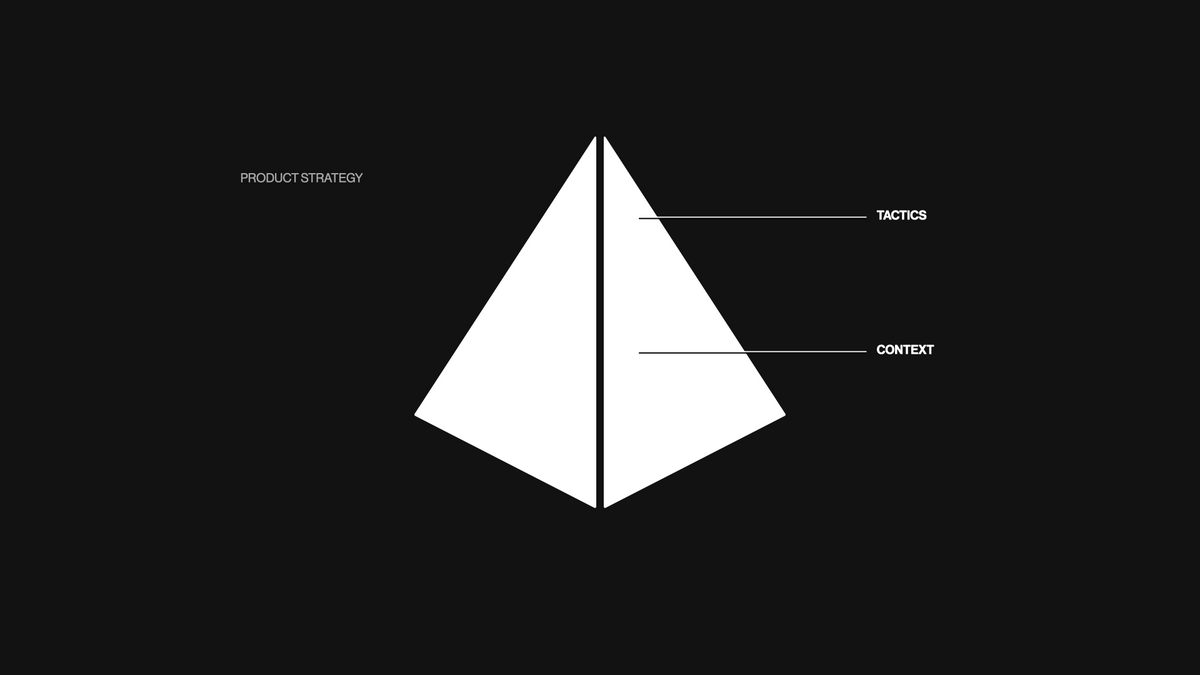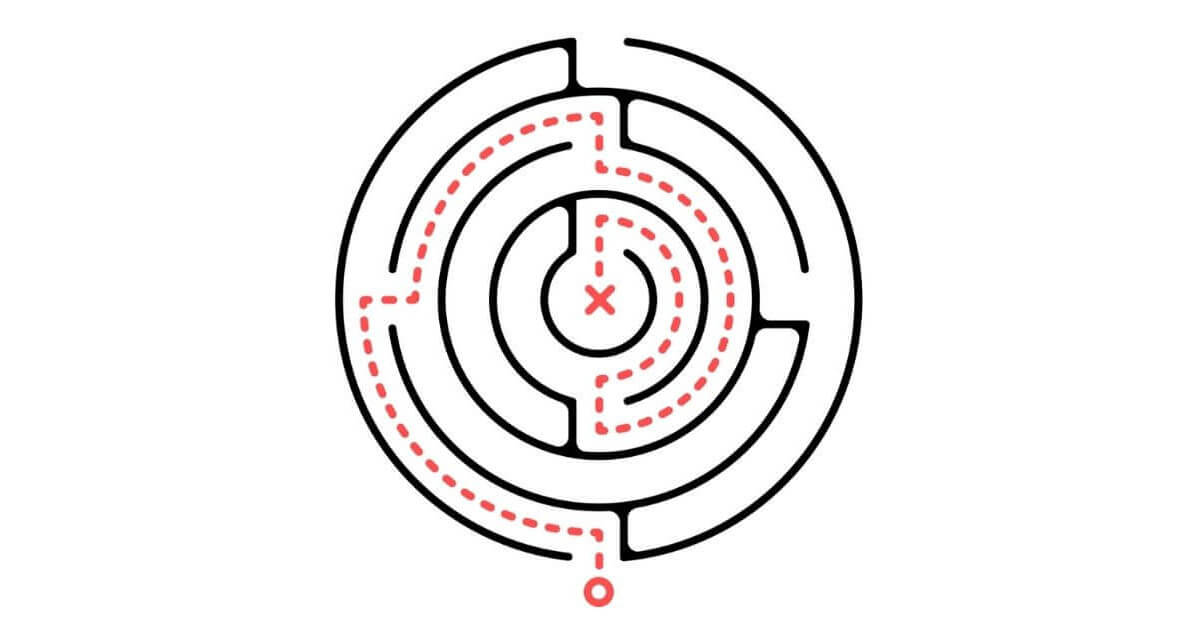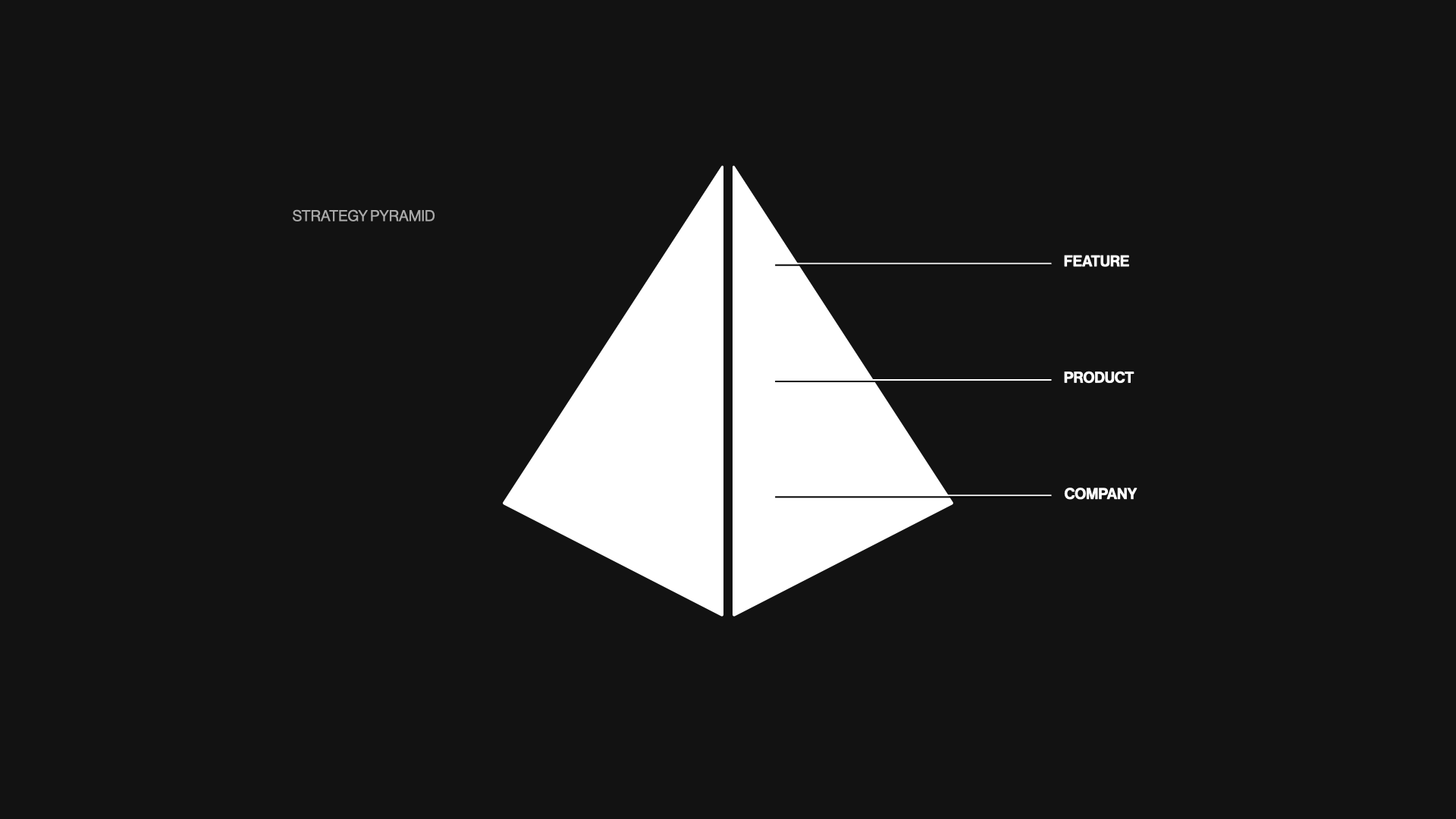Levels of Product Strategy: a framework from feature to company
Product strategy is the translation of the business strategy and product vision into actionable context and tactics. But how does it vary from company to feature-level mandates? Let's explore a framework.

Your product strategy is the overall context and plan for bringing a differentiated product to market, but the levels of context and detail will vary in a scaled product organization. In this article, I describe a two-level product strategy framework: company-level and feature-level product strategy. See the table below for details.

The size and complexity of your organization may require additional levels to support multiple products or product lines.
What Product Strategy Actually Is
Product Strategy is simply the unique path and choices you and your teams make to achieve your Product Vision. It is the map of how you intend to win the hearts and minds of your customers, and organizations achieve sustained success by continually delighting customers through innovation.
Your customers and the market do not care about your solution, they care about whether you solve their problems, whether it makes them feel cool, and whether it saves them time or money.

Guide & Playbook
Your Product Strategy becomes the guide and playbook used for team alignment, empowerment, and innovation. It describes the market and customers, the problems to solve and the functionality required to solve these problems, positioning (and counter-positioning), and creates focus for the roadmap required for achieving the vision.
Author, entrepreneur, and venture capitalist Peter Thiel describes disruptive innovation as being 10x better than existing alternatives. If you believe Thiel to be right, you must ask yourself: what does 10x better actually look like?
If you can't answer this question, how do you expect to delight your customers?
Feature-level Product Strategy
In this Productboard article, I described the elements of feature-level product strategy and include a template for getting started quickly.
A good feature-level product strategy will have a clear vision statement, connect to business objectives, describe the target customer, product objectives, measurable outcomes, and tactics.
You can develop your own product strategy with your product team by following six steps: defining your product vision, identifying your target market or customer, deciding what problem you’re solving, identifying your competitive differentiators, developing your high-level strategic roadmap, and outlining your go-to-market approach.

Scaling the Product Organization
Product leaders successfully scale their product strategy across many teams by clarifying who the customers and users of the product are, what customer needs or problems the teams must solve for, and which tactics will solve those problems.
But the key is actually the secrets shared within the organization. These secrets are the unique market and customer insights that employees will not find through searching Google or reading Medium articles.
Many of these secrets should be codified via principals that shorten decision-making times and bring clarity to hard choices.
They are the memes your organization lives and builds by – the literal memes of production.
Flawed Foundation, Flawed Execution
Product leaders provide company-level guidance through the overall context and priorities for the product, enabling product managers to set a clear product strategy for their product team.

Company strategy, product strategy, and feature strategy form a pyramid of efforts. Choices about brand, positioning, go-to-market strategy, and the value chain inform the overall product strategy. As activities move further up the stack, the foundational elements inform activities, decisions, and shortcuts performed the teams building the actual product.
A flawed foundation leads to flawed execution.
Product Strategy is the High-leverage Document
A well-defined product strategy helps product leaders and teams make informed decisions about allocating organizational resources and growing the business. Your product strategy becomes the playbook for alignment, achieving and expanding product/market fit, and widening your strategic moat.
Aligning the Organization
A clear product strategy aligns the entire organization around the customer, the fundamental of the business, and what must be done to win the market. This enables scaled context in high-growth environments like startups where total employee headcount grows exponentially each year. Additionally, the product strategy clarifies areas of investment and why some teams may receive more or less support in their work.
The company-level product strategy brings everyone to the same level of context without needing the product leader to sit in on every meeting or weigh in on every decision.
Finding and Expanding Product/Market Fit
Finding the right product for the right market is a difficult task. It’s a moving target as new players enter the market, new technology or platforms change customer behavior, the sales and/or marketing targets new segments, and customer expectations increase. Clarifying the ideal /segments and the capabilities needed for them focuses product teams on the right problems to solve.
Once product-market fit is found, the product strategy acts as guidance for product-market fit expansion: through new use cases, new target customers segments, or all new products.
Create and Widen Your Strategic Moat
A smart product strategy directly impacts a company’s 7 Powers, adding to economies of scale, network effects, branding, switching costs, cornered resource, and process power.
For example, choosing to invest in scalable systems, building viral features, bringing the brand voice and visuals into the product, centralizing data as a system-of-record, developing unique technology, or creating a unique product discovery process are all potential activities that widen a company’s strategic moat and have the potential to be influenced by the product strategy.
Investing in these areas over years makes it incredibly difficult for new companies to directly compete with your business. Netflix is a great example of this... while currently losing market share to Disney or HBO, Netflix enjoyed a monopoly on streaming memberships for over a decade.
More thoughts on developing your business strategy and business model in the last issue:

All of this is great, but how do successful teams create a winning strategy?
Having a clear product strategy is a good first step that will set you apart from the majority of competitors. Clearly identifying and describing the context and tactics needed for your product will place you in the top 10% of companies.
However, success is not guaranteed.
Execution is everything and it is difficult to know the future. Three characteristics observed in winning strategies include a clear vision for the future, differentiation for the target market, and collaborative cross-functional teams.
Clear vision for the future
Nearly every company has a mission and vision statement. Few craft one that inspires employees to continually innovate and push toward that better future.
Markets, technologies, and platforms will change over time, disrupting strategies focused too narrowly on how things work today. Great companies and products focus on the customer and the vision for the future, leveraging emerging technologies.
Great leaders continually tell stories about what that future looks like and how great it will be once we are all there.
Product Differentiation
The best products surprise and delight the market. They save time, make people money, create a sense of belonging, or entertain in new, unexpected ways. Winning product strategies contain the insights and secrets from hundreds of hours spent deeply understanding the needs of the market. Those insights are then translated into principles, opportunities, and areas for differentiation.

Nobody wants another email client, yet every year a new teams build yet another email client hoping to change the world.
Superhuman is one of the first teams to find success in doing this, but they are doing something different... they focused on the right differentiation for the people that 1) live in email, and 2) are willing to pay to make living in email great again.
Play together, win together
Winning products have superior distribution and stick in the minds of customers. Companies with winning product strategy bring the sales and marketing departments close to the engineering, product management, and design departments.
If you want to go fast go alone, if you want to go far go together.
– Ancient Proverb
They share insights and play the same game, focused on the right customer and the right markets. In short, they build for, position toward, and sell to the same ideal customer.
Where most organizations fail
Unfortunately, there are many areas where teams and leaders fail in regards to rolling out their product strategy. Most product organizations fall short by not setting or widely sharing the product strategy, underdeveloped or undefined market, customer, or differentiation, or by having the wrong mix of product investments.
Unknown Product Strategy
Glossing over companies with no product strategy, many product organizations create a product strategy that suffers from no distribution across the company. No one knows it exists and therefore believes there is no product strategy.
Counter this problem by thinking about the rollout of your product strategy as an internal marketing campaign.
Underdeveloped or Undefined Market/Customer, or Differentiation
The foundation of any product strategy is the deep understanding of the customer and the market. Without this, teams are set to fail as their work appeals to no one, eroding the product retention due to poor customer acquisition, acquiring the wrong customers, or losing ground to competitors better serving the same segment.
Counter this problem by clearly identifying the market, who the customer is, what their un- or under-served needs are, and how to differentiate from existing alternatives.
The test I use? I ask who from my network can I reach out to talk about this new app or feature. If it's hard to identify one person, you likely don't have a clear customer.
Wrong Mix of Product Investments
The output of a great product strategy is a portfolio of bets. Unconscious bias tends to poison this portfolio during the selection process.
Organization and teams typically bias toward a specific technique or framework for making product decisions. Some focus on big bets, some focus all teams on one problem, some focus each team on unique problems, some focus on the vision, some focus on customer feedback, and others focus on business metrics.
The company product strategy is like an investment portfolio, and should present a mix of short-term and long-term investments with different pay-back periods.
Focusing entirely on one area can lead to:
- Customers not feeling heard
- A lack of differentiation
- Gaps in core product metrics
- Complaints about the core use case
- Lack of – or no – product/market fit expansion
Developing Your Strategic Mindset
This article (and site) contains a number of frameworks and tactics for developing your product strategy. The key to long-term success is not following step-by-step tactics every single time.
Instead, success is informed by your ability to develop your strategic mindset, principles, and a deep understanding of when to use – and not use – specific tactics.
Many of the ideas in this site are built upon the following mindsets/principles:
- Speed – Your ability to get things done and learn faster than the competition is a significant competitive advantage. Speed is a killer feature.
- Risk – Doing anything new incurs a level of risk and failure, but this can be mitigated by applying portfolio theory to the types of work, and developing a “thinking in bets” mindset.
- Present Thinking – Reaching the future product vision takes time and patience. Instead of focusing on the future end state, ask what is the ideal current state?
- Decisions – Clearly identifying the decisions necessary to achieve your strategy sets you apart from the competition. Identify owners and delegate decision-making to those with the most context.
- Growth – Sustained growth is a factor of learning, doubling down on winners, clarifying your flywheel model, and viewing the product as part of a loop.
- Curiosity – Earned secrets widen your competitive advantage, bring the team closer together, and fuel innovation. A significant portion of your time must be dedicated to understanding the world around you: customers, needs/problems, and the market.
You got this. See you next time.
Recommended Reading








